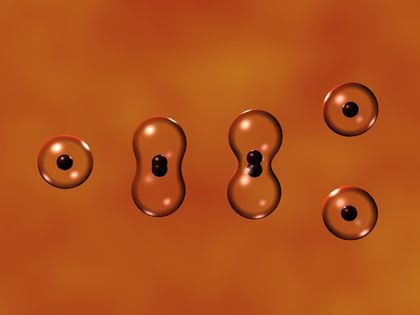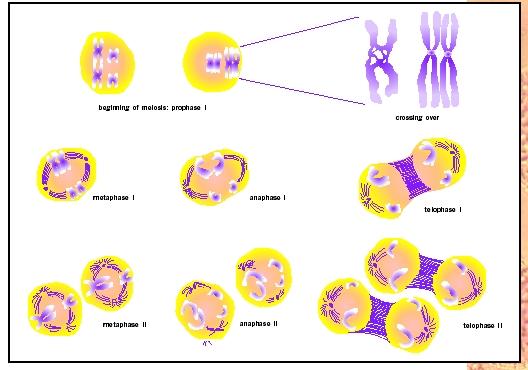Meiosis

Meiosis is the two-step series of specialized cell divisions that makes sexual reproduction possible. Meiosis produces haploid cells, which contain just one member of every chromosome pair characteristic of an organism. In all animals, specialized cells in the reproductive organs, called germ cells, undergo meiosis to produce haploid gametes (sperm and egg), which then fuse during sexual reproduction to create new diploid embryos. For example, human gametes are haploid and contain twenty-three different chromosomes. All other cells in the human body are diploid, containing two versions of each chromosome for a total of forty-six. Fusion of gametes to form a new embryo restores the diploid number characteristic of the organism, and it mixes maternal and paternal genes to give new combinations of traits. Meiosis itself also yields great genetic diversity in the resultant gametes through two mechanisms: (1) independent assortment of chromosomes at both of the meiotic divisions; and (2) physical exchange of chromosomal regions through a process called crossing over. Both processes create new chromosomal combinations, resulting in an array of genetically diverse gametes from a single individual.
Plants, fungi, and some protists also perform meiosis. In plants, meiosis creates a multicellular haploid organism, called a gametophyte , which in some groups is independent of the diploid plant. Gametes are produced by mitosis of the gametophyte, which then fuse to form the embryo. This cycle is called alternation of generations.

Chromosome Basics and Meiosis Overview
As noted, diploid cells contain pairs of chromosomes, each member of which carries the same set of genes. One member of each pair is inherited from the mother, and one from the father. The two pair members are called homologous chromosomes , or homologs.
Prior to meiosis, the diploid cell replicates its deoxyribonucleic acid (DNA). During replication, each chromosome duplicates itself to form two identical copies, which remain attached at a region known as the centromere . Each copy is known as a chromatid ; thus, each chromosome is composed of two identical sister chromatids.
During meiosis, homologous chromosomes line up and exchange segments, a process called crossing over. Following this, homologs are separated from each other in the first meiotic division. Next, in the second meiotic division, chromatids are separated from each other, in a process which is mechanically identical to mitosis. The result is four haploid cells. The coordination of the two meiotic chromosomal divisions gives meiosis its distinctive characteristics: a reduction in the number of chromosomes by half, accompanied by mixing of parental chromosomes, and swapping of regions between homologous chromosomes.
Meiosis I
Consider a spermatocyte or oocyte about to embark on meiosis. This diploid cell contains one set of chromosomes contributed by its mother and one set of chromosomes contributed by its father. Following DNA replication, the unique aspects of the first division of meiosis (meiosis I) begin. Because meiosis reduces chromosome content, a mechanism must ensure that every final haploid gamete has both the correct number and the correct set of chromosomes, with one member of each homologous pair. Meiosis I guarantees this by keeping each chromatid pair together and aligning homologous pairs of duplicated sister chromosomes prior to the first chromosomal division. The alignment and subsequent separation of pairs of homologous chromosomes during meiosis I thus sets up the mechanism that ensures that all four haploid gametes will contain the correct complement of chromosomes. Interestingly, the mechanism whereby meiosis aligns homologs also results in reciprocal exchanges of DNA between aligned chromosomes.
Alignment of homologous chromosome pairs begins before meiosis I, when each duplicated set of chromosomes seeks its homologous partner pair within the oocyte or spermatocyte. The underlying DNA sequence homology of the similar maternal and paternal chromosome pairs guides this search and eventual alignment along the entire length of each chromosome. The alignment is further mediated and cemented by a three-dimensional zipperlike structure surrounding each set of paired homologous chromosomes, the synaptonemal complex. In the process of these alignment steps, specific enzymes nick and then rejoin DNA at different places along the paired chromosomes. This process of genetic exchange is called meiotic recombination, or crossing over. Crossing over provides an attachment that holds homologous chromosomes temporarily in place and, at the same time, produces progeny chromosomes consisting of a patchwork of material from each of the originals. Thus, the two central characteristics of meiosis, reduction in chromosome number and genetic rearrangements, are intimately intertwined.
Once all sets of chromosome pairs have established at least one such crossing over, correct assortment of chromosomes at meiosis I is ensured. The synaptonemal complexes dissolve and the newly rearranged chromosomes proceed through the second mechanism that generates genetic diversity at meiosis I: They assort independently of one another to opposite poles of the cell pulled by spindle fibers. Whereas one chromosome pair might divide so that its predominantly maternal chromosome moves to the cell's "north" pole, another pair of chromosomes will move its predominantly paternal chromosome to that same north pole. These chromosomal movements are randomly determined, yielding great genetic diversity of gametes in an organism with multiple chromosomes. In an organism with three homologous pairs, there are four different possible chromosome arrangements at the end of meiosis I. In humans there are more than 4 million possible arrangements.
Thus, overall, the first division of meiosis provides two major mechanisms for new genetic combinations: (1) cutting apart and pasting together various segments of homologous chromosomes to yield unique hybrid chromosomes; and (2) independent assortment of maternal and paternal chromosomes.
Meiosis II and Cytokinesis
As meiosis II begins, each daughter nucleus contains the haploid number of chromosomes (for humans, twenty-three). Each chromosome is composed of two chromatids attached at the centromere. The second division of meiosis separates the chromatids. Once again, spindle fibers provide the pulling power. Once chromatids are separated, they are called chromosomes, and so at the end of meiosis II, each of the four new cells has the haploid number of chromosomes. Following this, cytokinesis occurs, in which the cytoplasm of the original cell is divided and membranes form to separate the new cells. Cytoplasm is divided evenly in sperm, but unevenly in eggs. During egg formation, most of the cytoplasm is allotted to one of the cell products, leaving one functional egg and several "polar bodies" that contain DNA and membrane, but little else. This unequal division gives the single egg a larger store of food to supply the developing embryo after fertilization .
Meiosis versus Mitosis
The alignment of homologous chromosome pairs in meiosis I and the accompanying physical exchanges between aligned chromosomes is unique to meiosis. In mitosis, by contrast, homologous chromosome pairs never or very rarely interact. Each mitotic chromosome duplicates, forming two sister chromatids, and then these two identical sister chromatids separate to opposite poles. While mitosis is specialized to produce entirely identical progeny, meiosis is specialized to produce a wide range of distinctive haploid progeny.
Mistakes in Meiosis
Among the many potential causes of infertility are problems with meiosis. If a person's spermatocytes or oocytes consistently produce sperm or eggs that contain an incorrect number or complement of chromosomes, then there will be great difficulty in producing a viable embryo.
A much more common situation arises from the rare, sporadic occurrence in a normally fertile person of an improper chromosome separation. When two chromosomes fail to separate as they should, a "nondisjunction" event has occurred. Such nondisjunctions are almost always lethal to the egg or sperm, or to the resultant embryo. There are exceptions, however. For example, approximately one out of one hundred men is the result of such a nondisjunction, which gave him an extra X chromosome. Such XXY individuals have Klinefelter's syndrome, a sex chromosome trisomy (three sex chromosomes instead of the normal two) with minor outward manifestations. Down syndrome individuals possess three copies of chromosome twenty-one instead of the normal two; their extra copy resulted from a nondisjunction of those chromosomes during one of the meiotic divisions of one of the parents.
SEE ALSO Alternation of Generations ; Chromosome, Eukaryotic ; Cytokinesis ; Mitosis ; Sex Chromosomes ; Sexual Reproduction
Wendy E. Raymond
Bibliography
Griffiths, Anthony J. F., et al. Modern Genetic Analysis. New York: W. H. Freeman and Company, 1999.
"Meiosis and Genetic Recombination." MIT's Biology Hypertextbook. <http://esg-.www.mit.edu:8001/esgbio/mg/meiosis.html> .
"Meiosis Tutorial." The Biology Project. <http://www.biology.arizona.edu/cell_bio/tutorials/meiosis/main.html> .
Comment about this article, ask questions, or add new information about this topic: